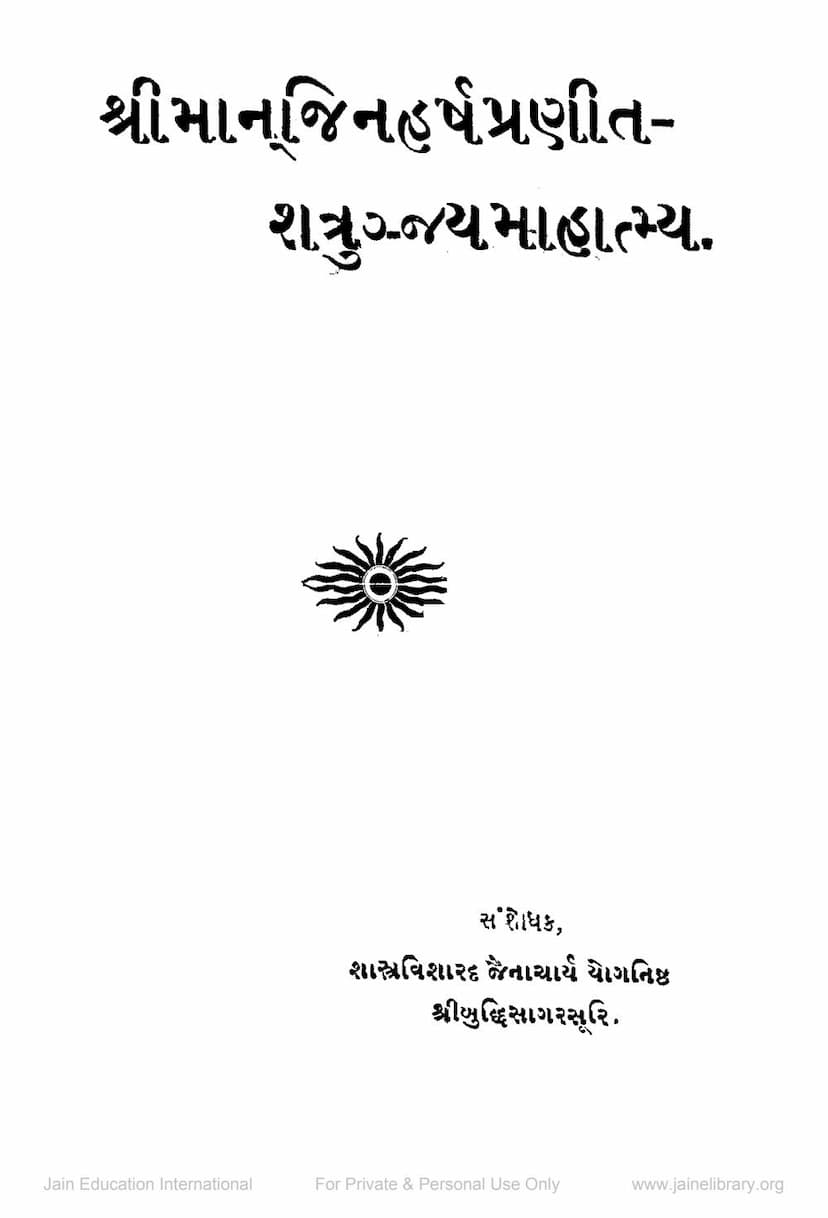Anand Kavya Mahodadhi Part 4
Added to library: September 1, 2025

Summary
Here's a comprehensive summary of the Jain text "Anand Kavya Mahodadhi Part 4" (known in Gujarati as "Anand Kavya Mahodadhi Part 4" or "Shri Anand Kavya Mahodadhi: Part 4"):
Overview:
"Anand Kavya Mahodadhi Part 4" is part of a larger collection of ancient Jain poetry. This particular volume, published by the Devchand Lalbhai Jain Pustakoddhar Fund in 1915, focuses on Shri Shatrunjay Mahatmya, a detailed account of the significance and glory of the sacred Jain pilgrimage site, Shatrunjay hill, also known as Palitana. The work is credited to Shri Buddhisagar Suri as the researcher and Jivanchand Sakerchand Javeri as the collector.
Key Themes and Content:
The primary focus of this volume is the Shri Shatrunjay Mahatmya, presented through a collection of poems, primarily in the Gujarati Ras (a type of narrative poetry) genre. The text aims to glorify the pilgrimage site of Shatrunjay and provide readers with an in-depth understanding of its religious importance, history, and the spiritual benefits derived from visiting it.
Content Breakdown:
-
Introduction and Publisher's Information:
- The book begins with the title, author information, and publisher details, highlighting the Devchand Lalbhai Jain Pustakoddhar Fund's commitment to publishing ancient Jain literature.
- It mentions that this volume is part of a series and is dedicated to preserving and promoting Jain literature in various languages.
- The catalog link provided is for Jainqq.org, indicating its availability in digital archives.
-
The Significance of Shatrunjay (Siddhachal):
- The text emphasizes Shatrunjay's supreme importance among all Jain pilgrimage sites. It explains the concept of "tirtha" (pilgrimage site) as a means to cross the ocean of worldly existence.
- It highlights that Shatrunjay is considered the holiest of all "sthavar tirtha" (immovable pilgrimage sites) where numerous Jina Tirthankaras and great souls attained liberation.
- The text describes the auspicious atmosphere of Shatrunjay, filled with the divine energy of liberated souls, which purifies the pilgrims and aids in their spiritual progress.
-
Historical Accounts and Narratives:
- The core of the work consists of detailed narratives, often in the form of Ras (poems), recounting historical events, stories of past kings, great souls, and miraculous occurrences associated with Shatrunjay.
- It traces the lineage of the Mahatmya's composition, starting from Pundrik Ganadhar, the chief disciple of Lord Rishabhadeva, who composed a vast work on Shatrunjay's glory. Subsequent versions by Sudharmaswami and Dhaneshwar Suri are also mentioned, highlighting the continuous tradition of glorifying this sacred place.
- The text delves into the reign of King Shiladitya of Vallabhi, his patronage of Jainism under the guidance of Dhaneshwar Suri, and the subsequent revival of the faith.
- It recounts the life stories of significant figures like Bhavad and Javd, showcasing their devotion and contributions to the upliftment and restoration of Shatrunjay.
- The collection includes various historical episodes that illustrate the spiritual power of Shatrunjay, including the influence of Jainism during the times of King Vikramaditya and his interaction with scholars like Siddhasen Divakar.
- It touches upon the societal and political conditions of ancient India, referencing foreign invasions and the spread of Jainism in various regions, as seen through the narratives of figures like King Jagammal.
-
Names and Praise of Shatrunjay:
- A significant portion of the text is dedicated to listing the numerous names of Shatrunjay, emphasizing its multifaceted glory and the benefits of reciting them. This section highlights the sheer reverence associated with the Tirth.
- The text elaborates on the immense spiritual merit gained by visiting Shatrunjay, stating that it surpasses the merits gained from visiting other holy places, even those in heaven or other realms, through simple devotion and remembrance.
-
The Author and Collaborators:
- The volume acknowledges the contributions of Shri Buddhisagar Suri for his scholarly research and editing.
- It also thanks Jivanchand Sakerchand Javeri for his role in collecting the ancient poems.
- The introduction mentions the efforts of individuals like Shri Kamalvijayji Gani, Pravartak Shri Kantivijayji, and Seth Maganlal Becherdas for their assistance in obtaining old manuscripts.
-
The Anand Kavya Mahodadhi Series:
- The publication is part of the "Anand Kavya Mahodadhi" series, which aims to collect and preserve old Gujarati poems, particularly those with religious and spiritual themes.
- The publisher, Sheth Devchand Lalbhai Jain Pustakoddhar Fund, is highlighted as a key institution in promoting Jain literature. The history and aims of the fund are briefly outlined, emphasizing its dedication to preserving Jain religious literature in Sanskrit, Prakrit, Gujarati, and English.
-
Linguistic and Literary Aspects:
- The text is written in old Gujarati, showcasing the literary richness of the language. The introduction acknowledges the compiler's desire to present the works of ancient poets and the meticulous effort taken to ensure the accuracy and completeness of the collection.
- The summary provides insights into the historical context, including mentions of periods of religious upheaval, the influence of Buddhism, and the flourishing of Jain scholarship during certain eras.
Purpose and Impact:
The purpose of "Anand Kavya Mahodadhi Part 4" is to:
- Glorify Shatrunjay: To instill deep reverence and devotion towards this holy Tirth among Jains.
- Educate: To provide historical and spiritual knowledge about Shatrunjay and the figures associated with it.
- Preserve Literature: To make ancient Jain poetry accessible to the current generation and ensure its survival.
- Promote Jain Values: To highlight the principles of Jainism, such as devotion, righteousness, and the pursuit of liberation.
In essence, this volume serves as a rich repository of ancient Jain devotional literature, offering a spiritual journey through the revered pilgrimage site of Shatrunjay and the lives of those who contributed to its sanctity.